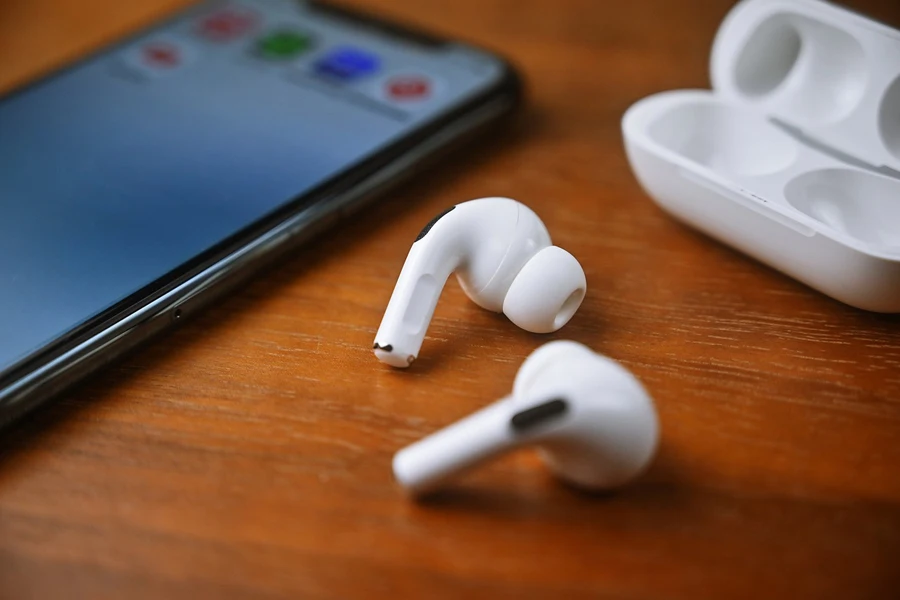Key Takeaway
- Market Growth: Valued at USD 71.5 billion in 2023, with a CAGR of 12.6% to 2030. Rapid growth in China (22.4% CAGR) and India (18.5% CAGR).
- Technological Advancements: Improved sound quality, wireless convenience, active noise cancellation(ANC), and gesture & touch controls. Wireless earphones dominate, with features like Bluetooth 5.0.
- Key Innovations: Personalized audio, health monitoring, advanced codecs, voice assistant integration, tangle-free cables, fast charge.
- Design Options: Includes in-ear, ear clip, and behind-the-neck designs etc.
- Factors to consider: Sound quality, mic quality, battery life, IPX rating.

In the rapidly evolving world of consumer electronics, earphones have become an essential accessory for many. Significant advancements in technology have led to superior sound quality, wireless convenience, and even health monitoring features in today’s earphones. The global market is expanding swiftly, driven by innovations such as Active Noise Cancellation (ANC) and true wireless earbuds. Key design improvements and personalized audio experiences further enhance user satisfaction. As the market continues to grow, understanding these innovations and selection criteria becomes crucial for informed purchasing decisions.
Table of Contents
● Market overview
● Key technology and design innovations
● Things to consider when selecting products
● Conclusion
Market overview

Market scale and growth
The global earphones and headphones market was valued at USD 71.5 billion in 2023 and is projected to grow at a CAGR of 12.6% from 2023 to 2030, according to Grand View Research. This growth is driven by the increasing adoption of wireless technologies, including Bluetooth and true wireless earbuds, which offer enhanced convenience and sound quality. The rise in popularity of streaming services and the integration of fitness-oriented features in earphones further contribute to market expansion.
Regional insights
Significant regional growth is observed in the Asia Pacific, with countries like China and India leading the charge due to their large consumer base and rapid technological adoption. As reported by Grand View Research, the market in China is expected to grow at a CAGR of 22.4%, fueled by the demand for feature-rich, trendy designs. Similarly, India’s market is projected to grow at a CAGR of 18.5%, driven by the emergence of local brands and the increasing preference for wireless devices.
Key technology and design innovations

Wireless connectivity and true wireless earbuds
Bluetooth technology, particularly Bluetooth 5.0 and higher, has dramatically improved wireless connectivity, offering increased range, faster data transfer, and more stable connections. True wireless earbuds eliminate all wires, using separate, synced earpieces to provide a seamless listening experience. Advanced models feature low-latency modes, crucial for gaming and video streaming, ensuring audio-visual synchronization.
Noise cancellation technology
Active Noise Cancellation (ANC) utilizes a combination of feedforward and feedback microphones to detect ambient sounds. These microphones, coupled with digital signal processing (DSP), generate inverse sound waves to cancel out background noise. High-end ANC earphones, like those with hybrid ANC systems, use multiple microphones both inside and outside the ear cup for more effective noise cancellation across a broader range of frequencies.
Personalized audio experience
Earphones now come with integrated digital signal processors (DSPs) that allow for real-time audio customization. Features like customizable equalizers and adaptive sound profiles use machine learning algorithms to adjust sound settings based on the user’s listening habits. Personalized calibration tools measure individual ear canal acoustics using in-app hearing tests to fine-tune audio output for optimal sound quality.
Advanced audio codecs
Advanced audio codecs such as aptX HD, AAC, and LDAC support high-resolution audio streaming over Bluetooth. AptX HD, for instance, supports 24-bit audio at a bitrate of up to 576 kbps, significantly reducing latency and enhancing sound quality. LDAC, developed by Sony, can transmit audio at up to 990 kbps, allowing for near-lossless audio quality over wireless connections.
Biometric sensors and health monitoring
Earphones equipped with biometric sensors use optical heart rate monitors and pulse oximeters to track health metrics. These sensors use photoplethysmography (PPG) to measure blood flow and oxygen saturation. Advanced models integrate accelerometers and gyroscopes to provide detailed movement and activity tracking, syncing data with fitness apps for comprehensive health monitoring.
Gesture and touch controls
Modern earphones feature capacitive touch sensors and accelerometers to enable intuitive gesture controls. These sensors detect taps, swipes, and even proximity, allowing users to control playback, adjust volume, and manage calls without physically pressing buttons. Some models include adaptive touch sensitivity, which adjusts the responsiveness of the sensors based on user preference.
Augmented reality (AR) integration
AR-enabled earphones use spatial audio technology and motion sensors to deliver an immersive audio experience. By tracking head movements and overlaying 3D soundscapes onto the real world, these earphones enhance gaming and interactive applications. Features like sound localization and directional audio cues provide a more engaging and realistic AR experience.
Things to consider when selecting products

Design options
In-ear design
In-ear earphones, often called earbuds, use dynamic or balanced armature drivers. They are popular for their portability and ability to form a seal within the ear canal, providing passive noise isolation. Advanced models may feature hybrid driver systems combining dynamic and balanced armature drivers for enhanced sound quality across all frequencies.
Ear Clip Design
Ear clip earphones typically use dynamic drivers and feature ear loops made from flexible materials like silicone or thermoplastic elastomers. These loops provide a secure fit without penetrating the ear canal, making them suitable for users who prioritize comfort and hygiene. Some models include additional hooks or fins to enhance stability during vigorous activities.
Behind-the-neck design
Neckband earphones house larger batteries and electronic components in the neckband, allowing for longer battery life and more features. They often incorporate multiple drivers per earpiece, such as dual dynamic drivers or hybrid setups, to deliver high-fidelity audio. The neckband may also include tactile buttons or touch-sensitive controls for easy operation.
Connectivity: Wired or wireless?
Wired earphones
Wired earphones connect via 3.5mm TRS (Tip-Ring-Sleeve) or 2.5mm connectors, supporting high-resolution audio without compression. They utilize oxygen-free copper or silver-plated cables to minimize signal loss and maintain audio integrity. Some high-end models feature balanced connections with separate grounds for each channel to further reduce noise and crosstalk.
Wireless earphones
Wireless earphones leverage Bluetooth 5.0 or higher for improved range, faster data transfer, and better stability. Advanced models support high-definition codecs like aptX HD and LDAC, which offer bitrates up to 990 kbps, significantly enhancing audio quality. True wireless earbuds use synchronized dual-channel transmission to ensure both earpieces receive signals simultaneously, reducing latency and improving synchronization.

Key features
Sound quality
Earphones use various driver technologies to produce sound. Dynamic drivers are known for their powerful bass response, while balanced armature drivers offer detailed mids and highs. Some models use planar magnetic or electrostatic drivers for ultra-high-fidelity audio, delivering exceptional clarity and precision across all frequencies.
Bass quality
Bass response is influenced by driver size and type, as well as the earphone’s enclosure design. Larger dynamic drivers (e.g., 10mm or more) can produce deeper bass, while bass ports and acoustic chambers within the earphones enhance low-frequency performance. Some earphones also feature bass boost technology, which electronically enhances bass output.
Mic quality
Good quality microphones in earphones often use MEMS (Micro-Electro-Mechanical Systems) technology, providing superior noise cancellation and voice clarity. These mics are strategically positioned and may include multiple elements to capture sound from different angles, reducing ambient noise and focusing on the speaker’s voice.
IPX rating
The IPX rating system measures water and dust resistance. An IPX7 rating, for example, means the earphones can withstand immersion in water up to 1 meter for 30 minutes. Some models also feature nano-coating on internal components to prevent moisture damage from sweat or rain.
Playback time and battery life
Wireless earphones use lithium-polymer or lithium-ion batteries, with capacities ranging from 50mAh to 200mAh per earpiece. Charging cases typically offer additional power, extending total playback time. Advanced models feature quick charge technology, providing several hours of use from a short charging period, and can support wireless charging for added convenience.
Fast charge
Fast charge technology uses high-current charging circuits to quickly replenish battery levels. For instance, 10-minute charging can yield up to 2 hours of playback. This technology involves careful thermal management to prevent overheating and ensure battery longevity.
Tangle-free cables
Tangle-free cables use flat or braided designs to prevent knots and tangles. Materials such as Kevlar or nylon reinforce the cables, enhancing durability and flexibility. Some earphones incorporate magnetic tips that clip together, further reducing the risk of tangling when stored.
Voice assistant integration
Earphones with voice assistant integration use wake word detection and beamforming microphones to interact with digital assistants like Siri, Google Assistant, or Alexa. These systems process voice commands using onboard DSPs (Digital Signal Processors), enabling hands-free operation for tasks such as music control, navigation, and information queries.
Conclusion

As earphone technology advances, a wide range of options are available to suit various needs. Whether prioritizing superior sound quality, wireless convenience, or health monitoring features, the market caters to diverse preferences. Understanding key innovations and selection criteria enables informed decisions in this dynamic landscape, ensuring buyers find suitable products to meet their specific requirements.




